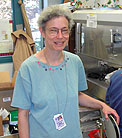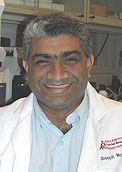
| T H E N I H C A T A L Y S T | N O V E M B E R – D E C E M B E R 2003 |
|
|
|
|
HOST RESPONSE TO INFECTIOUS DISEASES: SCIENTISTS USE NEW TOOLS, TRICKS TO BLOCK INFECTION |
text and photos by Peter Kozel |
 |
|
Kanta
Subbarao
|
New animal models for SARS, the role of T cells in SIV infection, and new vaccine targets were some of the intramural research highlights at the "Host Response to Infectious Diseases" minisymposium on October 15.
SARS Model
Kanta Subbarao kicked off the session with a description of work by NIAID’s Laboratory of Infectious Diseases, which is evaluating animal models for severe acute respiratory syndrome (SARS).
Subbarao delivered the virus into the noses of mice and observed that the virus replicated efficiently, although the animals didn’t become ill and displayed only mild histopathology. SARS virus was detected in lungs, and virus-specific hyperimmune sera from infected mice could be used to block infection in other animals. These results are similar to those for influenza and respiratory syncytial viruses in mice.
Subbarao also described her work with primates, including rhesus and African green monkeys and cynomolgus macaques. The virus replicated in the respiratory tract of all three monkey species without causing illness. All species developed neutralizing antibodies, but African green monkeys were protected from a second infection with SARS and proved to be the best model. Subbarao said both the primate and the mouse models would be useful in screening future SARS vaccines and antivirals.
 |
|
Thomas
Wynn
|
Reducing Cytokine Scarring
Up to 600 million people in 74 countries suffer from chronic schistosomiasis infections. The schistosome parasites cause spleen and liver enlargement and the formation of fibrous scars. Thomas Wynn, a senior investigator in NIAID’s Immunopathogenesis Section in the Laboratory of Parasitic Diseases, says cytokines are responsible for the scarring.Wynn’s group looked at T-cell responses to different cytokines and determined that by blocking IL-13, fibrosis was reduced. Mouse knockouts and IL-13 receptor agonists confirmed this observation.
Using additional knockout models, Wynn and his colleagues also demonstrated that when the decoy receptor for IL-13 was knocked out, fibrosis increased, arguing that there are both stimulatory and inhibitory receptors for this cytokine. Animals treated with a soluble form of the IL-13 receptor reversed the phenotype in the knockout mice, confirming that the IL-13Ra2 is acting as a "decoy receptor system," inhibiting fibrosis. Wynn's work is applicable to other chronic inflammatory diseases, including asthma and kidney conditions, that exhibit a "terminal stage of inflammation" comparable to the scarring in schistosomiasis.
Cytokine Keys and Intracellular Bugs
 |
|
Karen
Elkins
|
Intracellular pathogens pose special problems for treatment. Karen Elkins from CBER/FDA’s Laboratory of Mycobacteria demonstrated that B-cell knockout mice respond differently to infections of tuberculosis and Francisella, offering new insight into the basic biology of the diseases.
During aerosol tuberculosis infection, lung histopathology showed less-severe damage in B-cell knockout mice, and there was less dissemination of bacteria out of lungs to spleens and livers compared with wild-type controls. But lung tissues were more damaged, and dissemination restored, when B cells were added back to the mice. In contrast, secondary immunity to Francisella was impaired, not improved, in the absence of B cells.
Elkins was able to tease out a "common thread" in how infected macrophages control these kinds of bacteria. Macrophages and dendritic cells secrete IL-12 when infected; this cytokine helps activate production of interferon gamma (IFN-g), which increases nitric oxide production in macrophages. IFN-g is a necessary but not sufficient component of adaptive protective immunity; in fact, macrophages from mice lacking the interferon receptor eliminated up to 95 percent of bacteria.
Elkins’ elucidation of the varied roles immune cells play in infection by intra-cellular pathogens could have important long-term consequences for the treatment of these diseases.
For example, IFN-g is often suggested as both an additional treatment for intracellular pathogens (in combination with antibiotics), and as a marker or "correlate" of protection for vaccine studies. But these data, Elkins observed, suggest that IFN-g, while important, is far from the only T-cell function needed for protection against these bacteria. In fact, it may actually be a rather minor player; another cytokine, TNF-a, may be key. Further research is necessary to better define those other players, improving treatment options and aiding vaccine development.
 |
|
Suzanne
Epstein
|
New Vaccines Could Foil the Flu—And Other Viruses
Against a background of colorful autumn leaves that coincided with the return of flu season, Suzanne Epstein, chief of FDA-CBER’s Laboratory of Immunology and Developmental Biology, described new mechanisms to protect against the flu.
Epstein ascribed "lots of excess deaths" to this highly transmissible virus. Current vaccines provide a measure of protection, but would not stop pandemics such as those in 1918, 1957, and 1968. She cited the basic biology of influenza as the reason. The high mutation rate of this negative-strand RNA virus ensures that the outer coat proteins, to which many vaccines are directed, are constantly changing. Also, entire segments of the viral genome can be swapped between strains (genetic reassortment), bringing in new coat proteins.
In contrast, Epstein said, the proteins inside the viral particle are fairly conserved, making them excellent vaccine targets. The broad cross-protection they can induce, so-called "heterosubtypic immunity," can be achieved in animals by immunization with live virus and also with DNA vaccines. These new vaccines can deliver a conserved antigen, conferring immunity to many different viral strains and even across subtype differences, which occur in pandemics.
DNA vaccines have another advantage: they do not have to be kept cool, allowing millions of people to be immunized in places lacking adequate refrigeration. Epstein concluded by noting that influenza is not the only virus for which vaccines inducing broad cross-protection might be useful. The knowledge gained in the influenza system can suggest strategies for partial protection to other families of highly variable viruses, such as Hantaviruses and HIV.
 |
|
Joseph
Mattapallil
|
Tracking Memory Cell Loss In SIV-infected Macaques
Joseph Mattapallil, a research fellow in the flow cytometry core laboratory of the VRC, and his colleagues are using a rhesus macaque model in an attempt to gain insight into the extensive early loss of CD4 T cells in HIV infection.
Initial findings in rhesus monkeys infected with SIV showed that loss of memory CD4 T cells from the peripheral blood was preceded by a severe loss of B cells within a week of infection; this loss could not be accounted for by the expression of CCR5 (a SIV coreceptor) or the mucosal homing receptor CD103.
To determine how these memory CD4 T cells were lost, the investigators initiated a second study, which revealed that there was an extensive loss of CD4 memory T cells in the mesenteric lymph nodes within two weeks of infection. The loss was deemed due to direct infection, since more than 90 percent of these cells carried a single copy of SIV.
Whether this mechanism
reflects the kind of depletion of memory CD4 T cells that occurs in human infection
remains to be determined, Mattapallil said. ![]()